“CARAMBAS Y GÜIRAS”
Make the Conditions Dance: 50 Years of Kemnade International
© Heinrich Holtgreve
Kunstmuseum Bochum, Bochum (DE)
2024






about carambas y güiras
“In the summer of 2024, we celebrate the 50th anniversary of an experiment: in 1974, the Bochum Art Museum launched Kemnade International, a festival that focused not only on music and art, literature, and dance, but also on networking and shared knowledge. It became an outstanding example of the rich culture of our region, a culture that has long been shaped by migration. What remains of that utopia? What stories still need to be told, what dances still need to be danced? Together with artists from different generations and former festival participants, we have looked from the present into the living history of the festival.
Our large exhibition space becomes a platform of multi-voiced sounds and memories, offering suggestions for a new way of living together and a critical view of the present. How can a dialogue between generations succeed, and what does solidarity mean today? And how much festival can fit into a museum space? Following the logic of a festival ground, things happen here simultaneously and collectively. With playable instruments, installations, film, and archival materials, the exhibition is an invitation to come together again and, even today, make the circumstances dance once more.”
Our large exhibition space becomes a platform of multi-voiced sounds and memories, offering suggestions for a new way of living together and a critical view of the present. How can a dialogue between generations succeed, and what does solidarity mean today? And how much festival can fit into a museum space? Following the logic of a festival ground, things happen here simultaneously and collectively. With playable instruments, installations, film, and archival materials, the exhibition is an invitation to come together again and, even today, make the circumstances dance once more.”
©2025 pavelaguilar.com
“LITORAL”
Pavel Aguilar Solo Show at El Lobi.
Curated by Vanessa Hernádez Gracia
© Thais Llorca
San Juan (PR)
2024

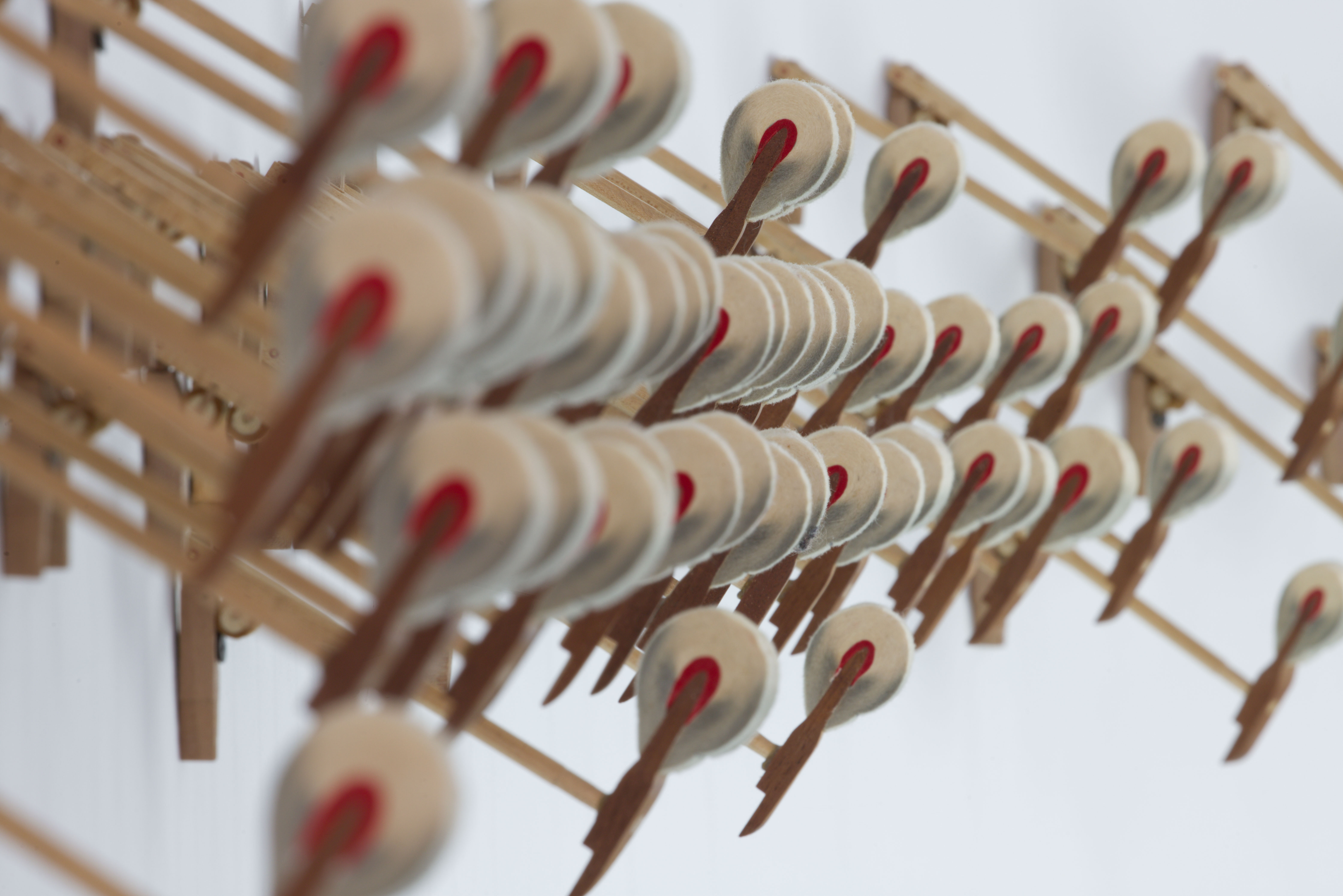
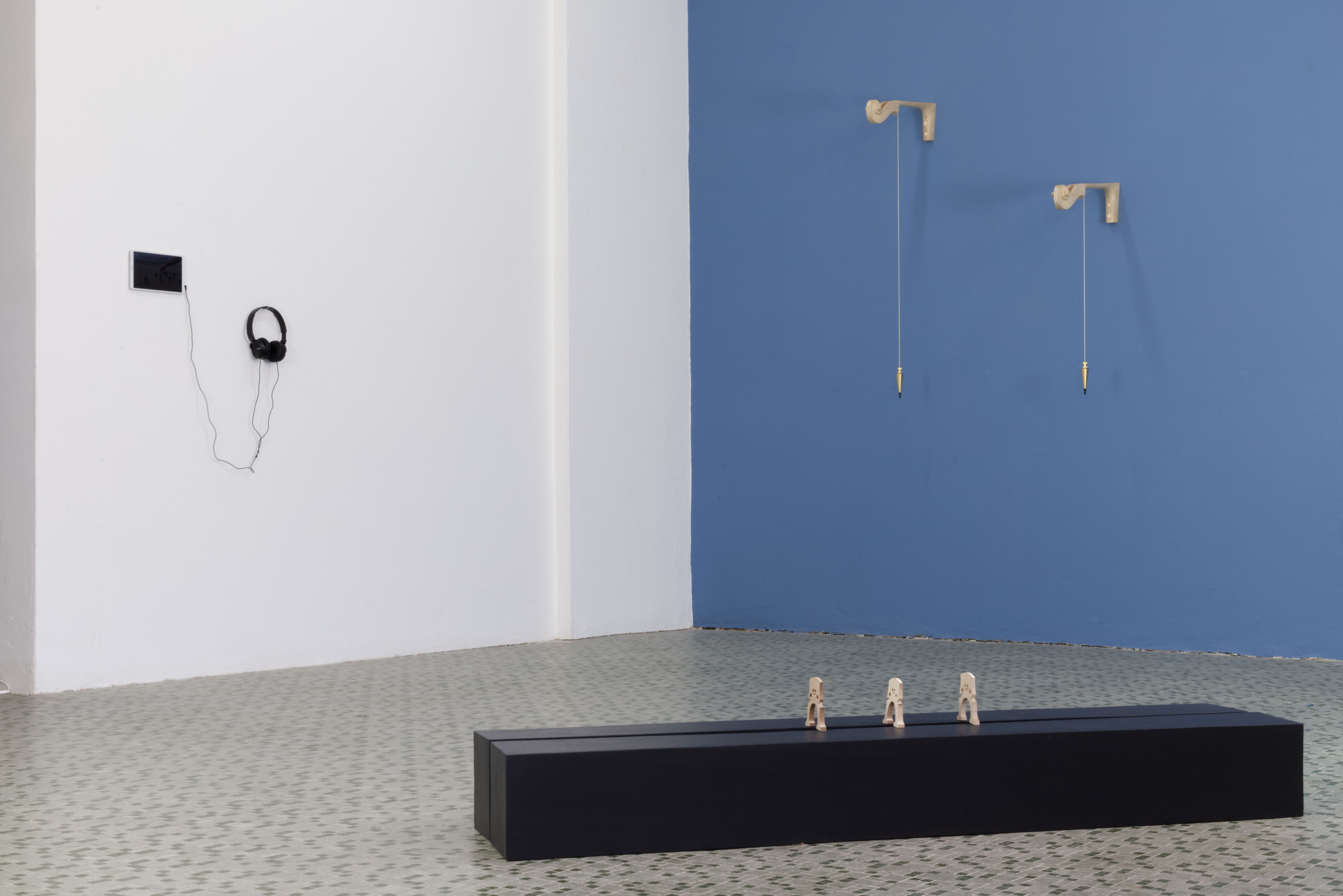
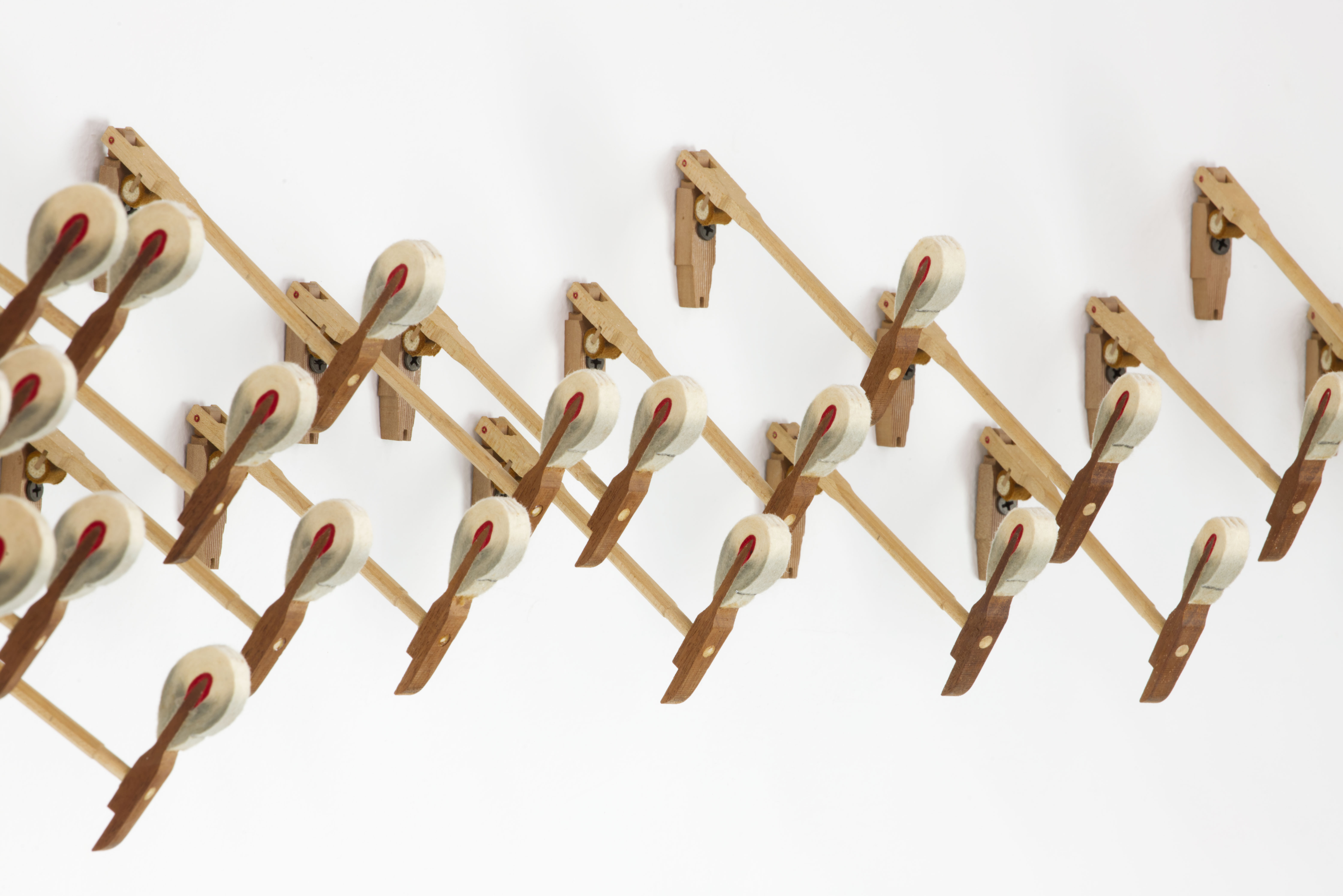
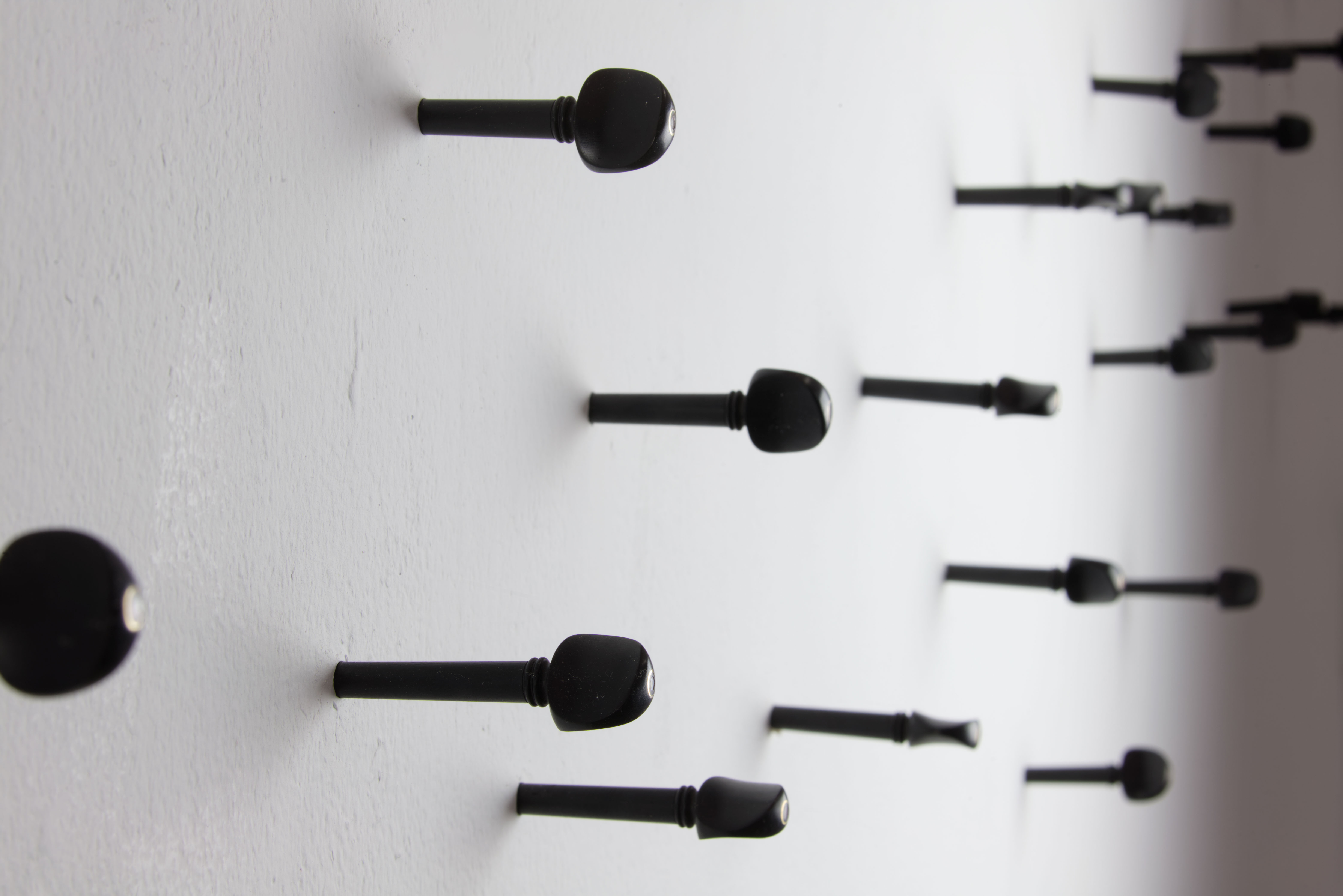
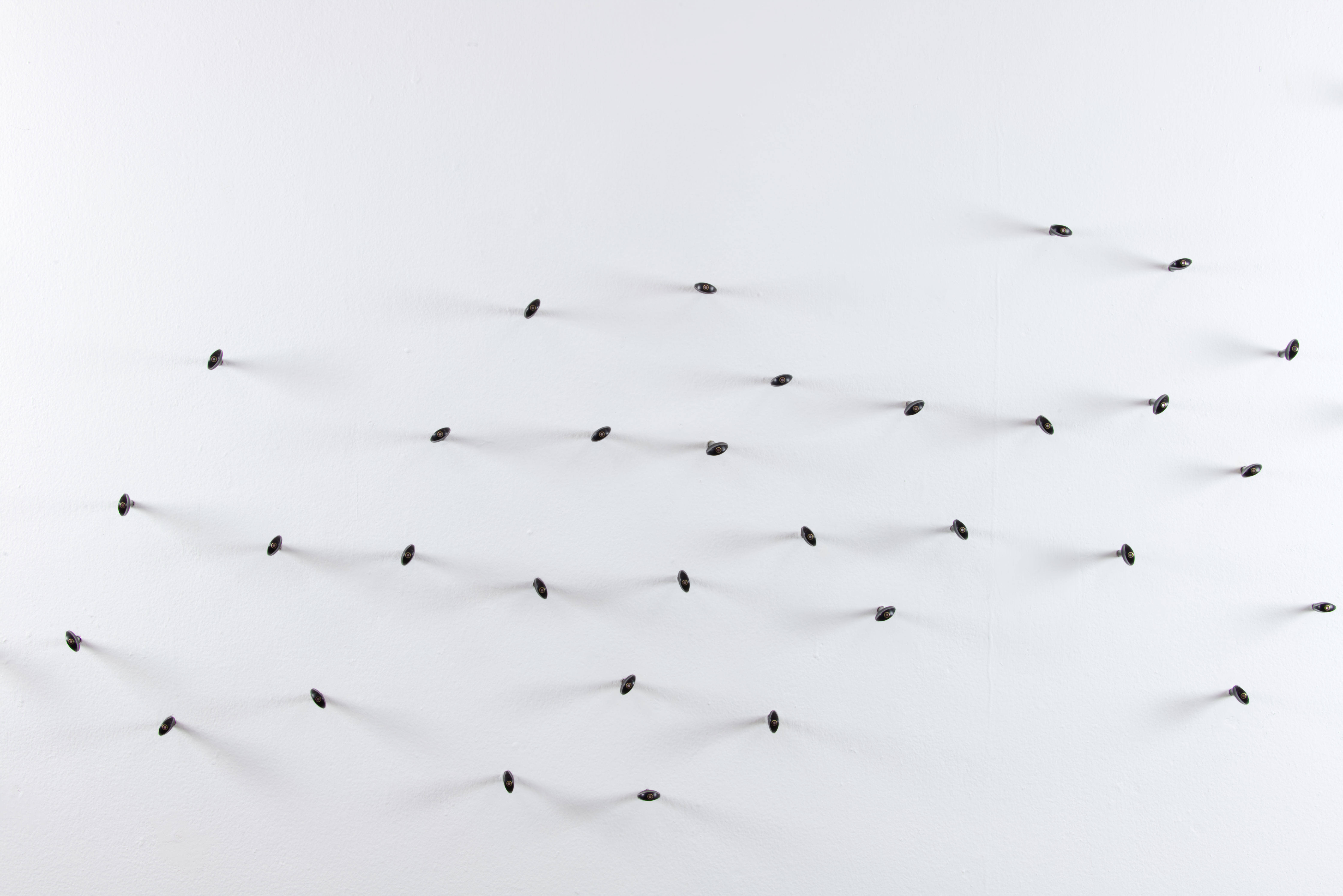



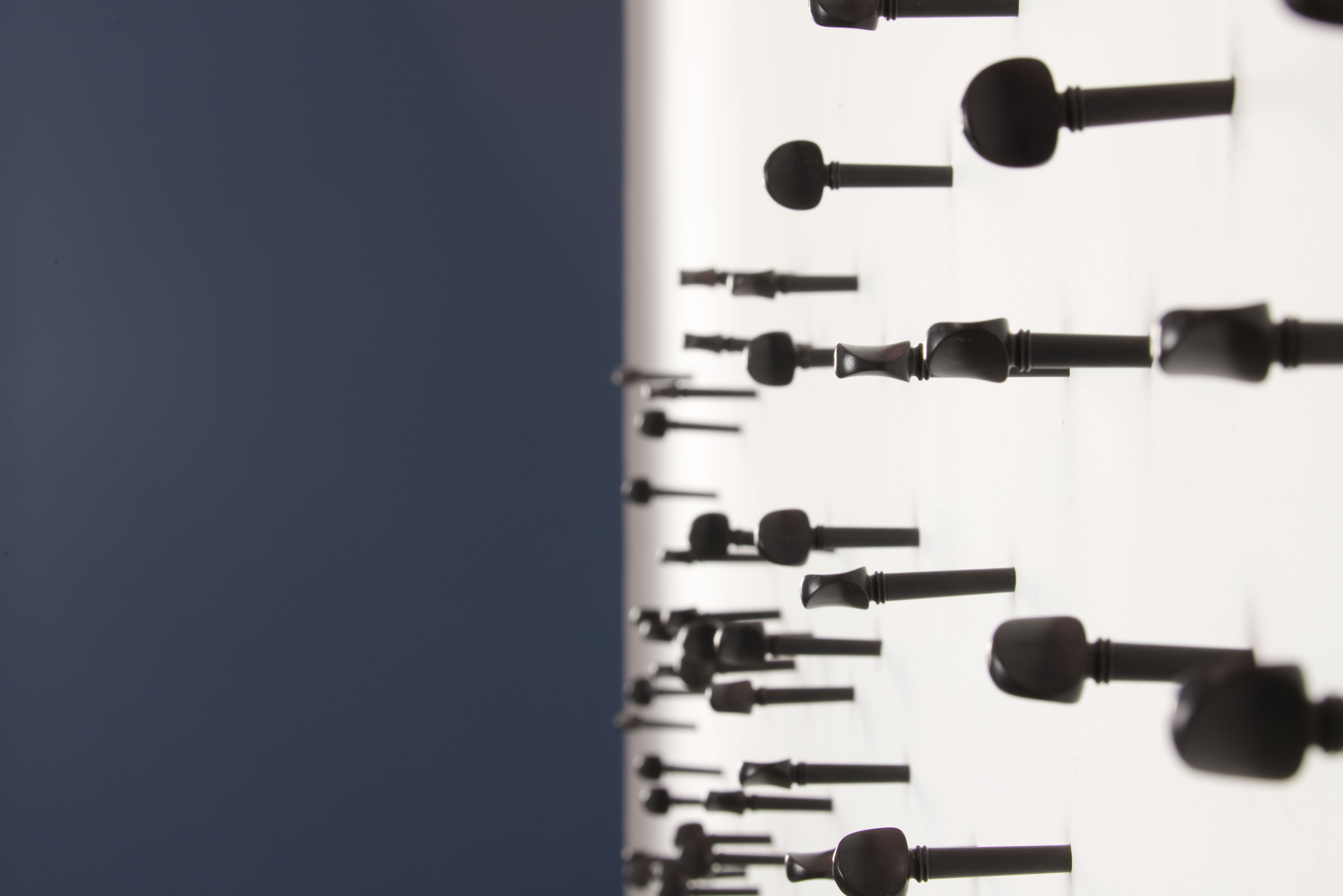
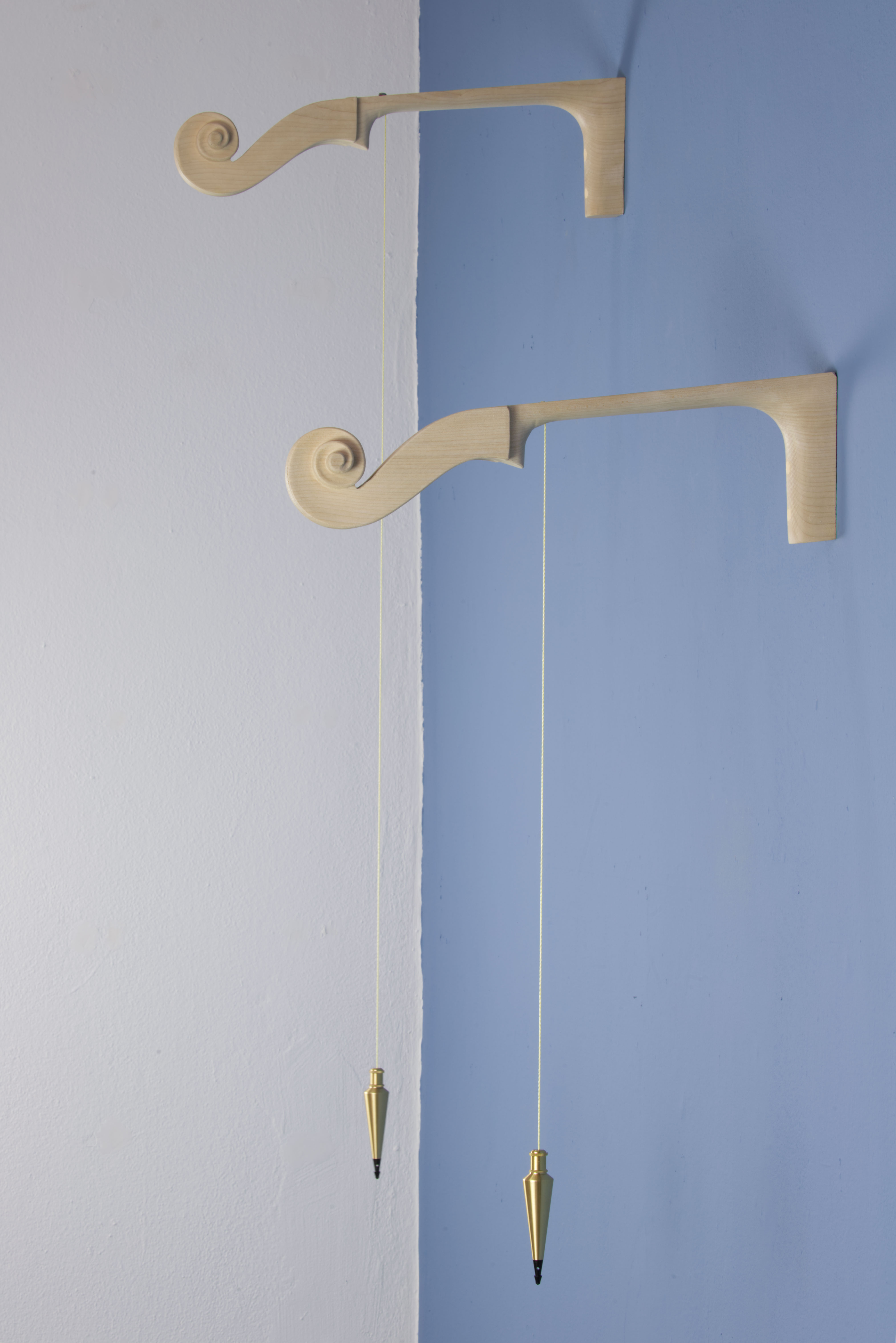
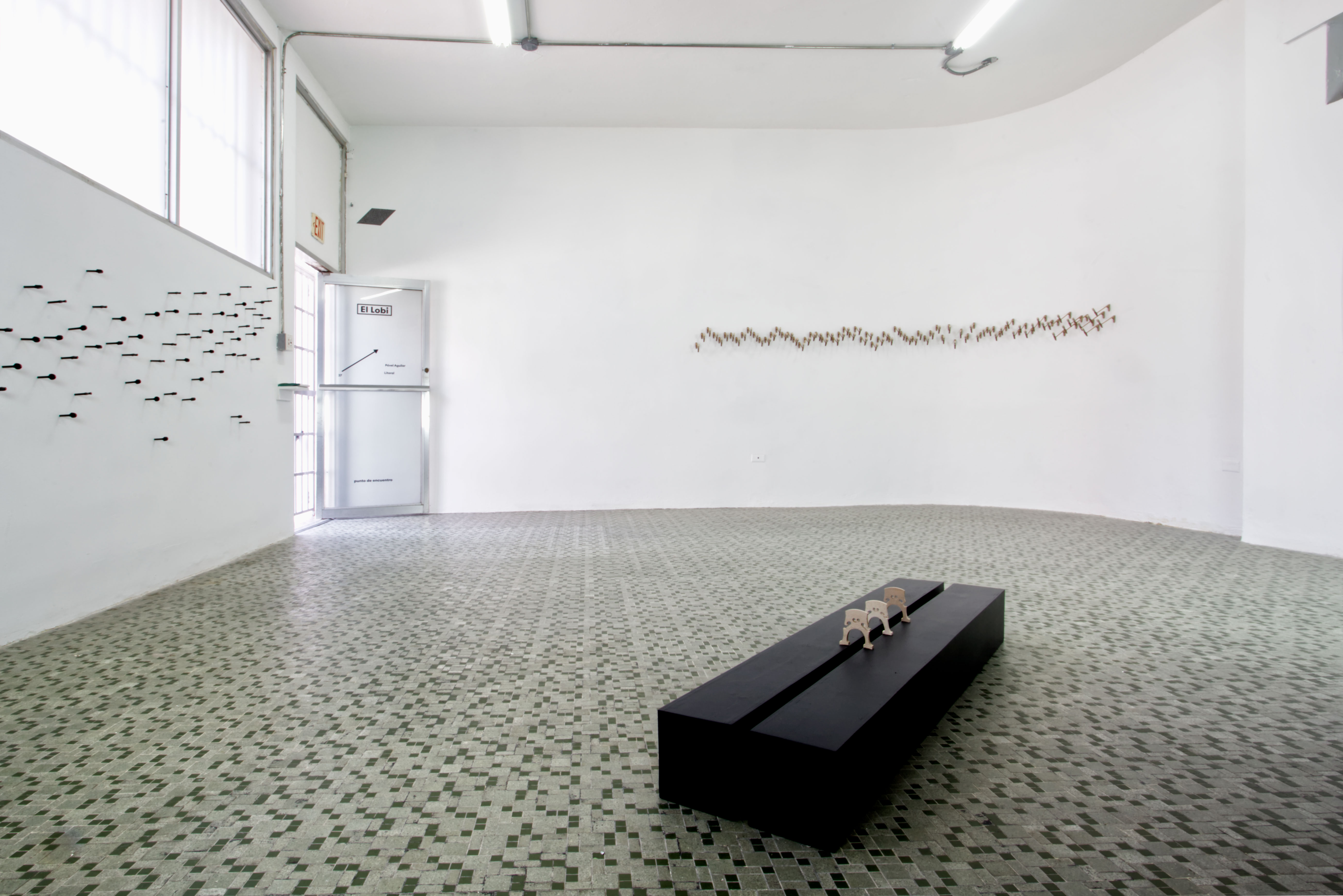
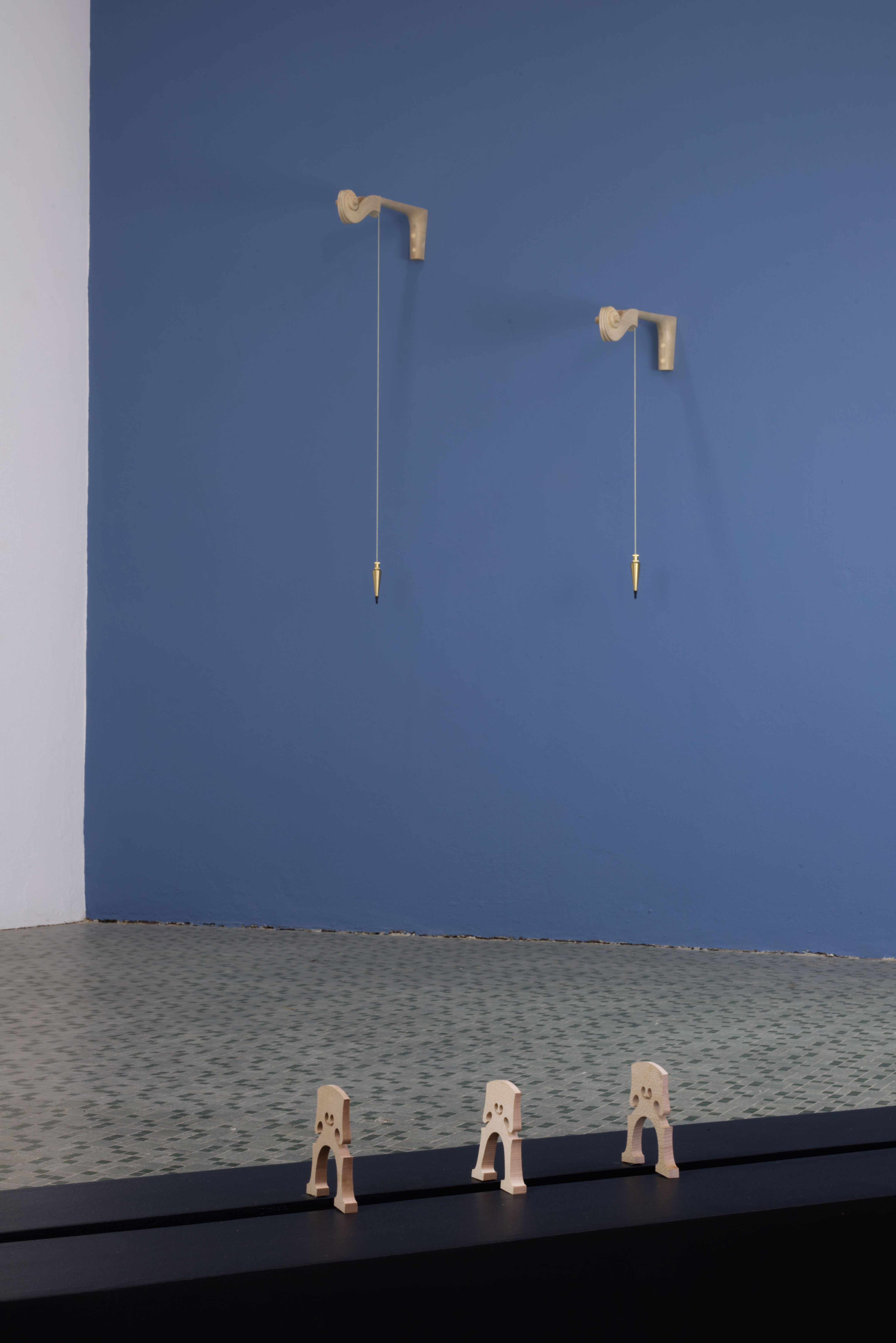
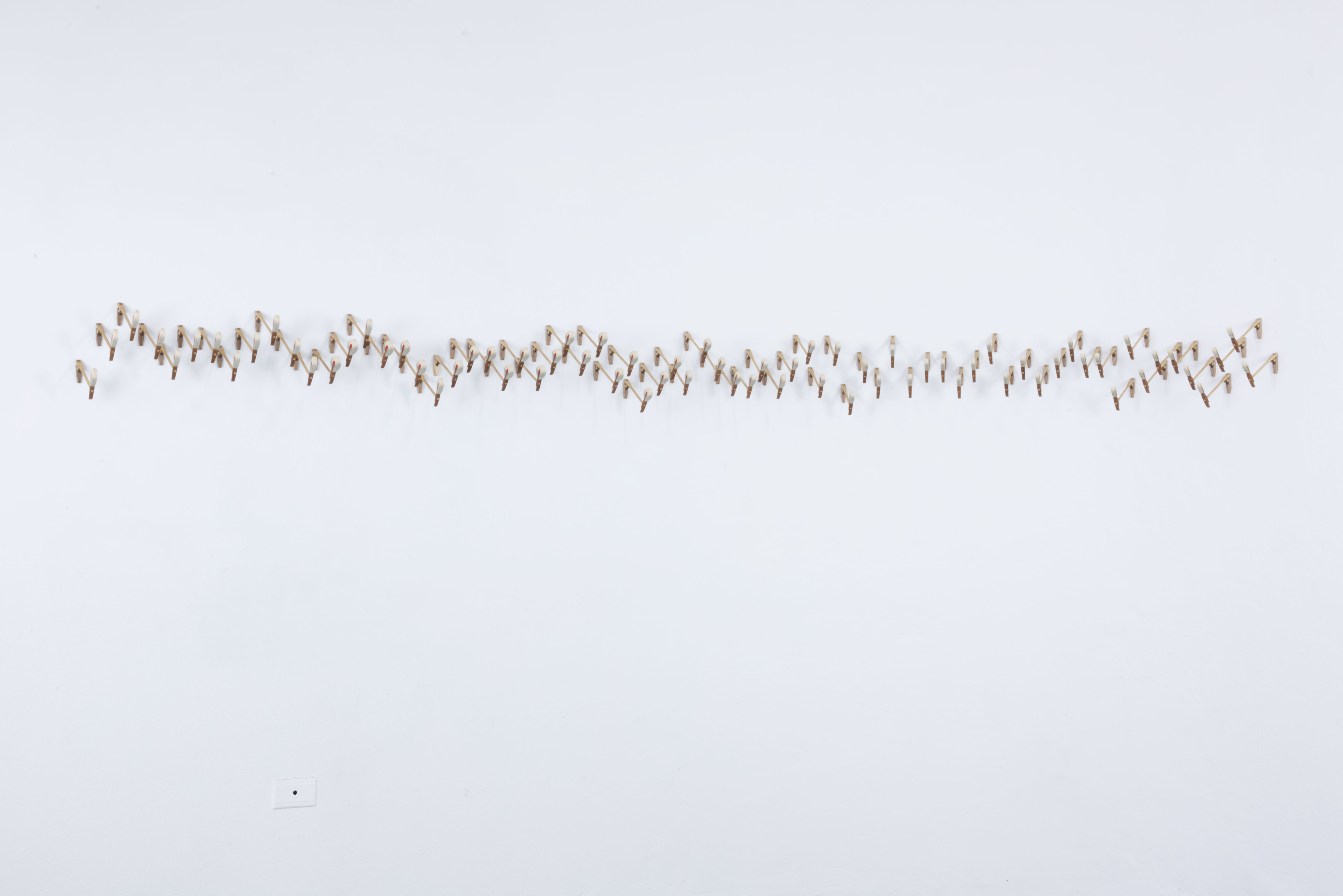
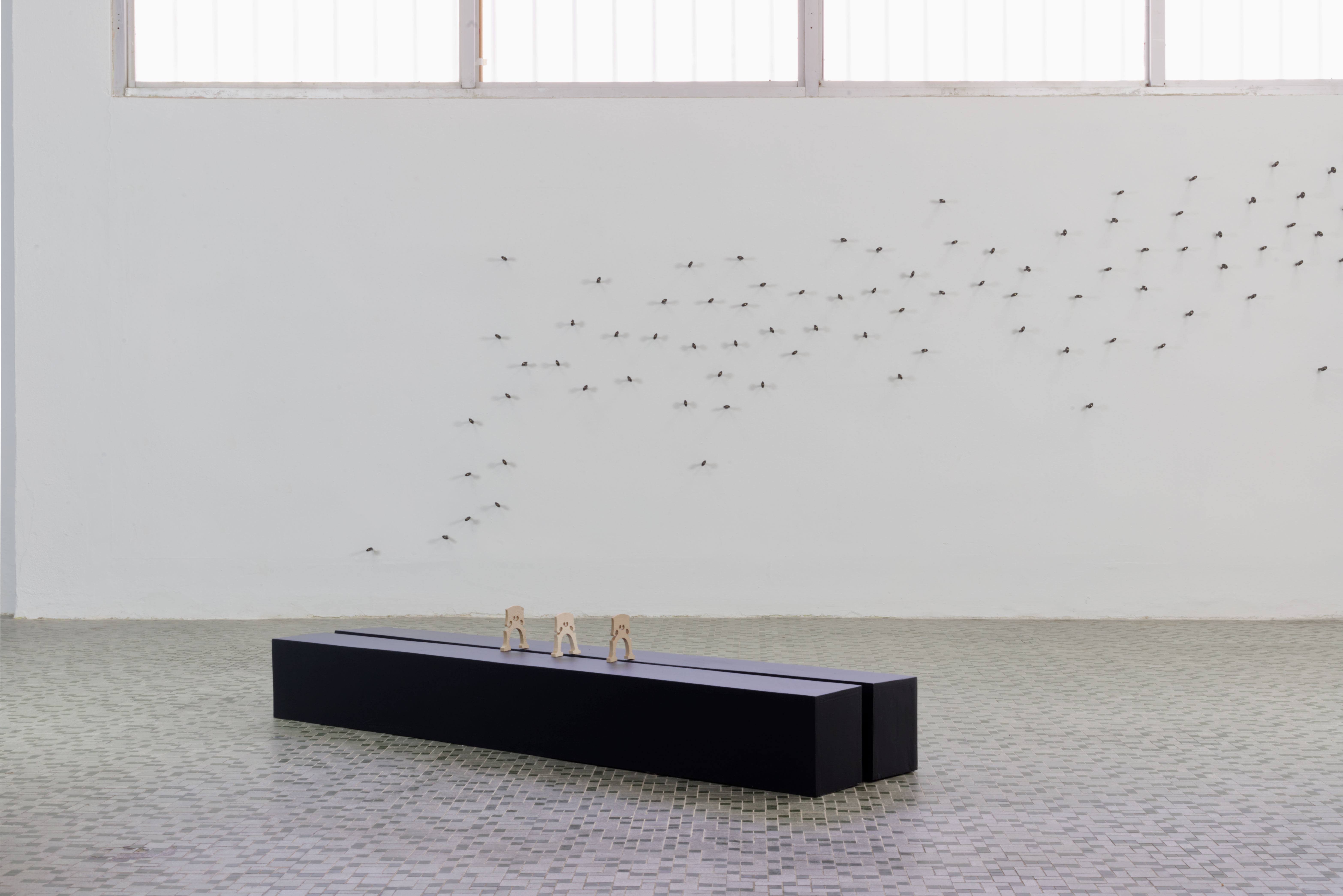

about litoral
“Litoral delves into the exploration of our sonic habitat as a central axis, deepening the relationship between sound and the environment in different geographical scenarios. From landlocked nations like Switzerland to territories surrounded by water like Puerto Rico, it examines the ways in which sound shapes the experience and perception of habitable space.
Through sensory stimuli, field recordings, and audiovisual narratives, spectators are led to reflect on how sound influences and conditions our living environment.”
Through sensory stimuli, field recordings, and audiovisual narratives, spectators are led to reflect on how sound influences and conditions our living environment.”
©2025 pavelaguilar.com
“THE GOLDEN RHYTHM”
HERE AND NOW. Anti-colonial Interventions
Museum Ludwig (DE)
2022

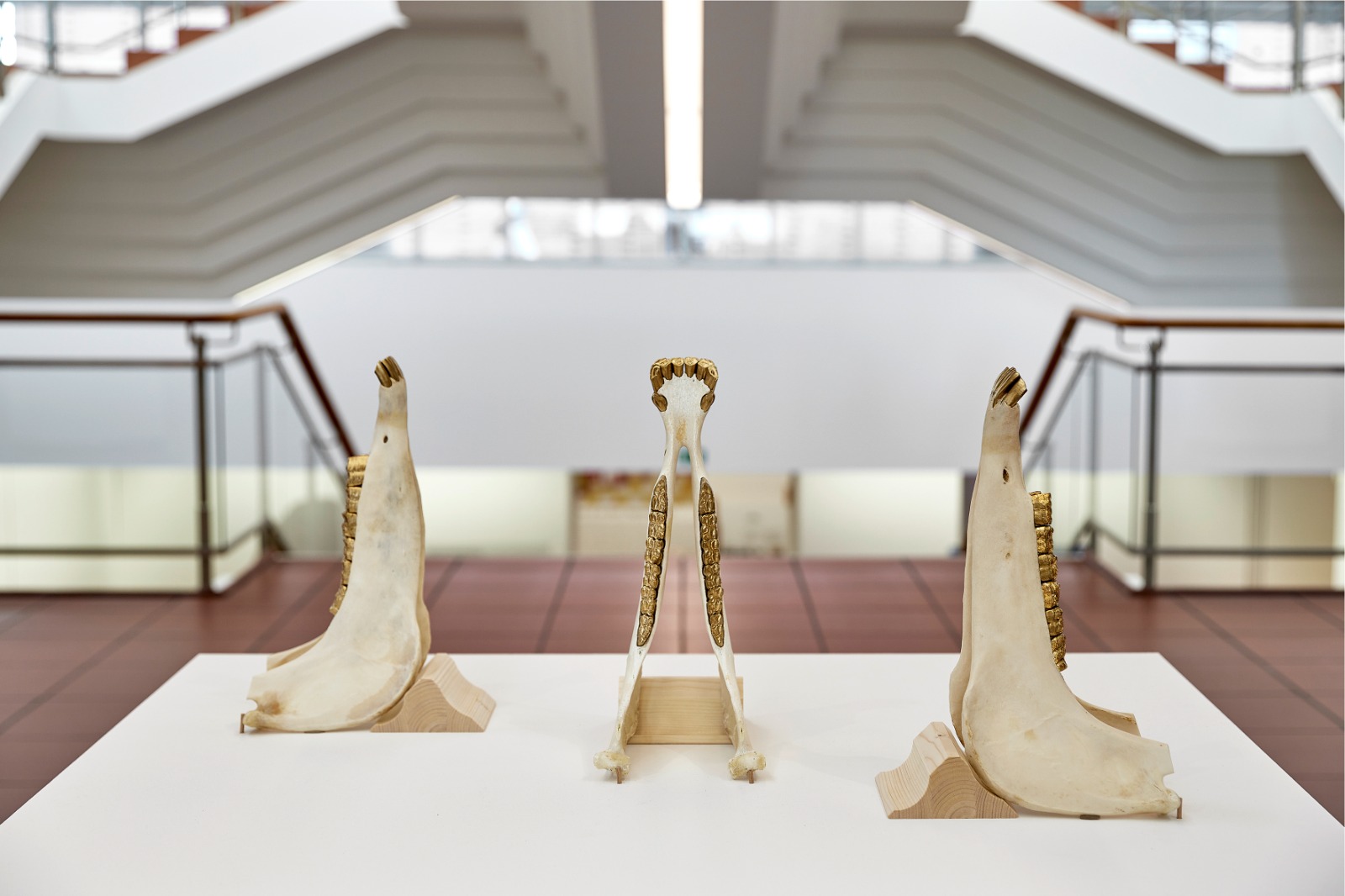
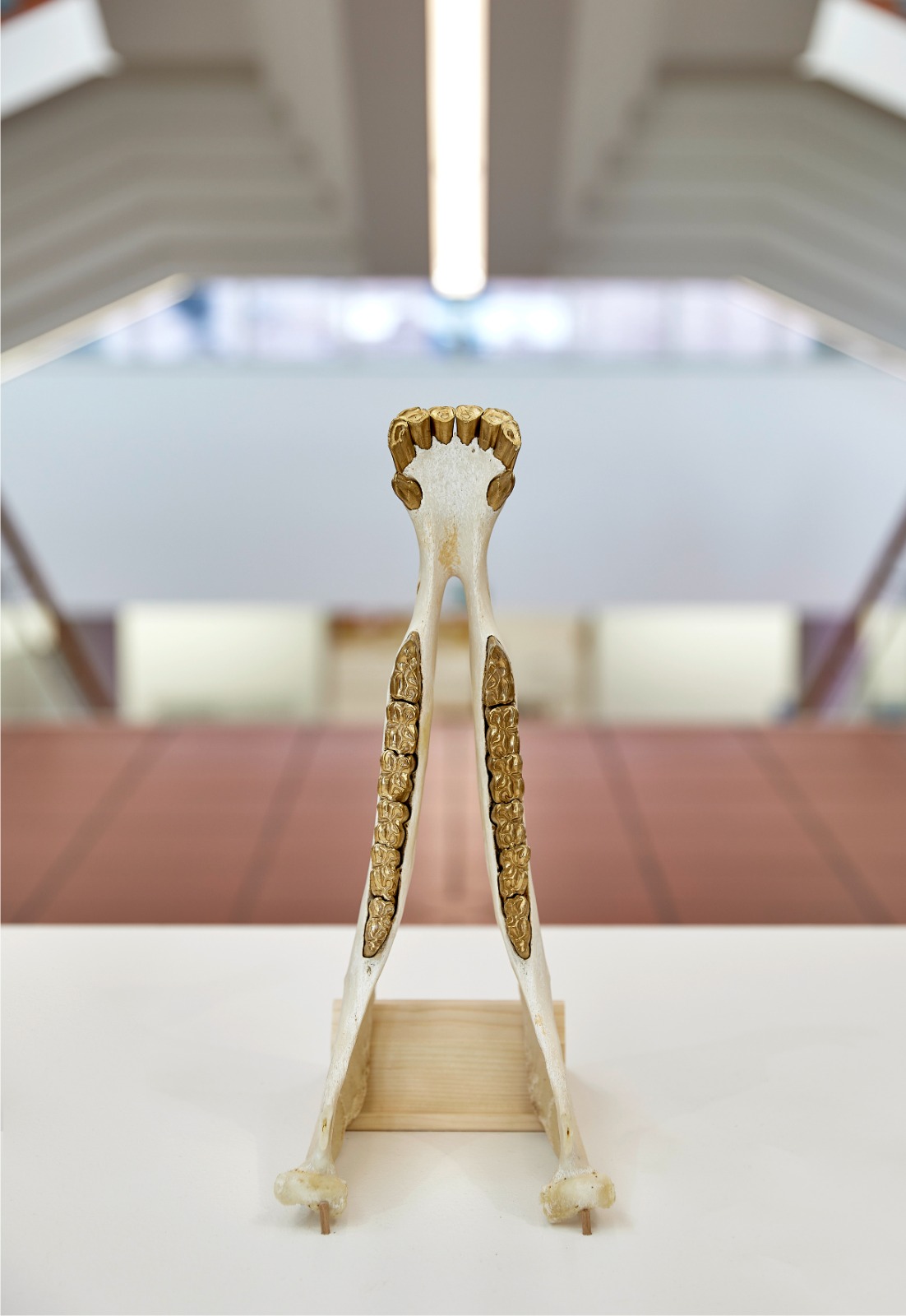
about the golden rhythm
“Donkey jawbones, such as the three gilded specimens in the work of Pavel Aguilar, have different meanings in various cultures. In some regions of Latin America and the Caribbean, for instance, quijadas are used as musical instruments: sounds are created by moving a wooden stick or plastic tube up and down or across the row of teeth.
Quijadas were also played in Africa and became firmly rooted in Afro-American culture through the colonial slave trade.
By contrast, the jawbone is associated in Christian tradition with Samson, who used the tool to slay 4,000 Philistines and liberate Israel. Cai Guo-Qiang’s installation The Age of Not Believing in God (1999), which is on display close to Aguilar’s work, features ten wooden sculptures that depict beings venerated in Christianity and Taoism, here pierced by 1,500 arrows.
While Cai is referring to the growing instability of religion in society today, Aguilar deals with the misappropriation of cultural objects, which, when displayed in a museum, are not allowed to be touched. A further connection to Christian iconography and colonialism is provided by the gilding of the teeth: one of the aims of colonial powers was to exploit land and people for the purpose of accumulating riches, especially gold, which was also used to decorate and furnish Catholic churches. This exploitation continues to this day.”
Joanne Rodríguez and Víctor Zaiden.
Quijadas were also played in Africa and became firmly rooted in Afro-American culture through the colonial slave trade.
By contrast, the jawbone is associated in Christian tradition with Samson, who used the tool to slay 4,000 Philistines and liberate Israel. Cai Guo-Qiang’s installation The Age of Not Believing in God (1999), which is on display close to Aguilar’s work, features ten wooden sculptures that depict beings venerated in Christianity and Taoism, here pierced by 1,500 arrows.
While Cai is referring to the growing instability of religion in society today, Aguilar deals with the misappropriation of cultural objects, which, when displayed in a museum, are not allowed to be touched. A further connection to Christian iconography and colonialism is provided by the gilding of the teeth: one of the aims of colonial powers was to exploit land and people for the purpose of accumulating riches, especially gold, which was also used to decorate and furnish Catholic churches. This exploitation continues to this day.”
Joanne Rodríguez and Víctor Zaiden.
©2025 pavelaguilar.com
“FUGA”
Picture a Vaccum!- Kunstkredit Basel-Stadt
Group Show. Curated by Eva-Maria Knüesel
Kunsthalle Basel (CH)
2021



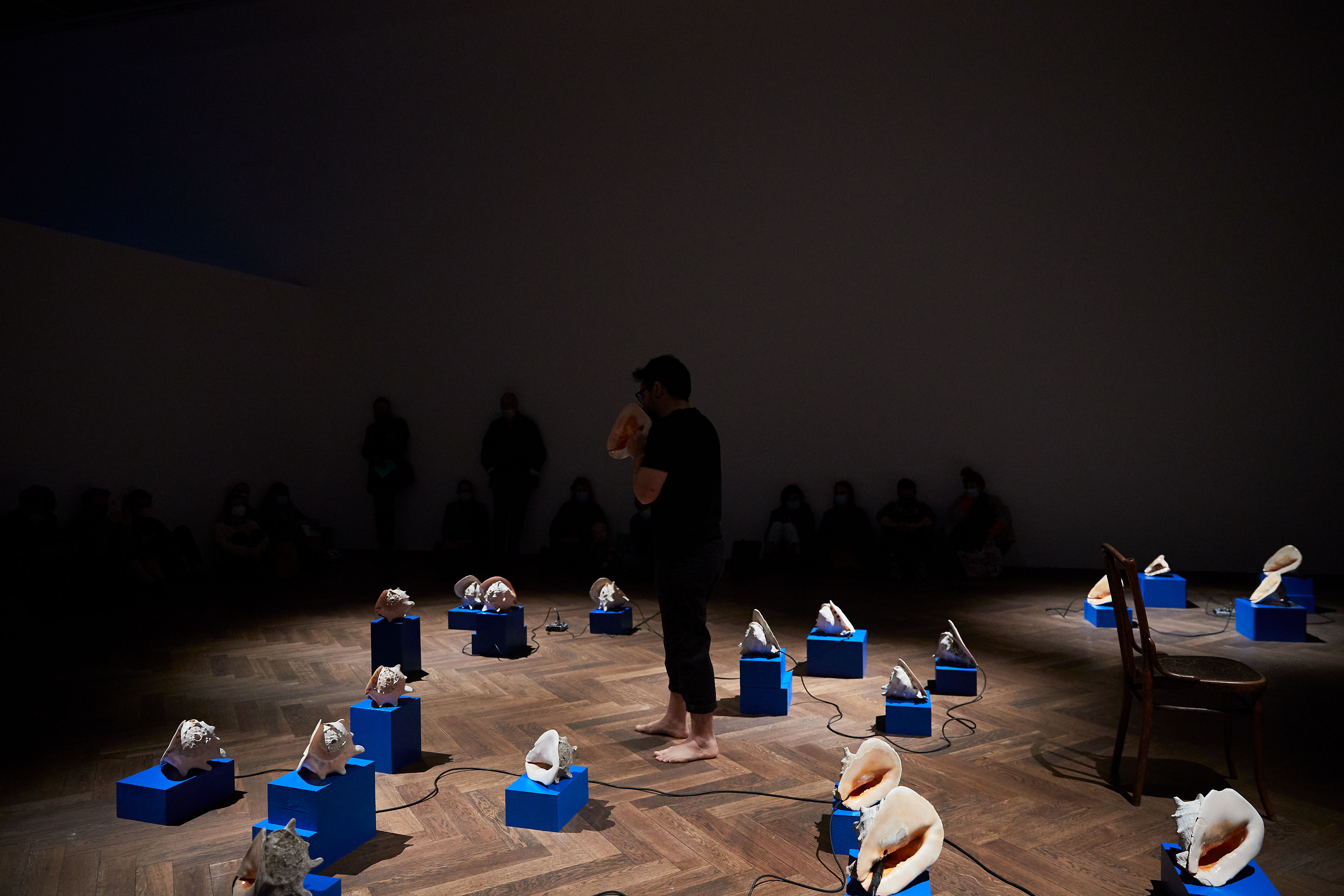



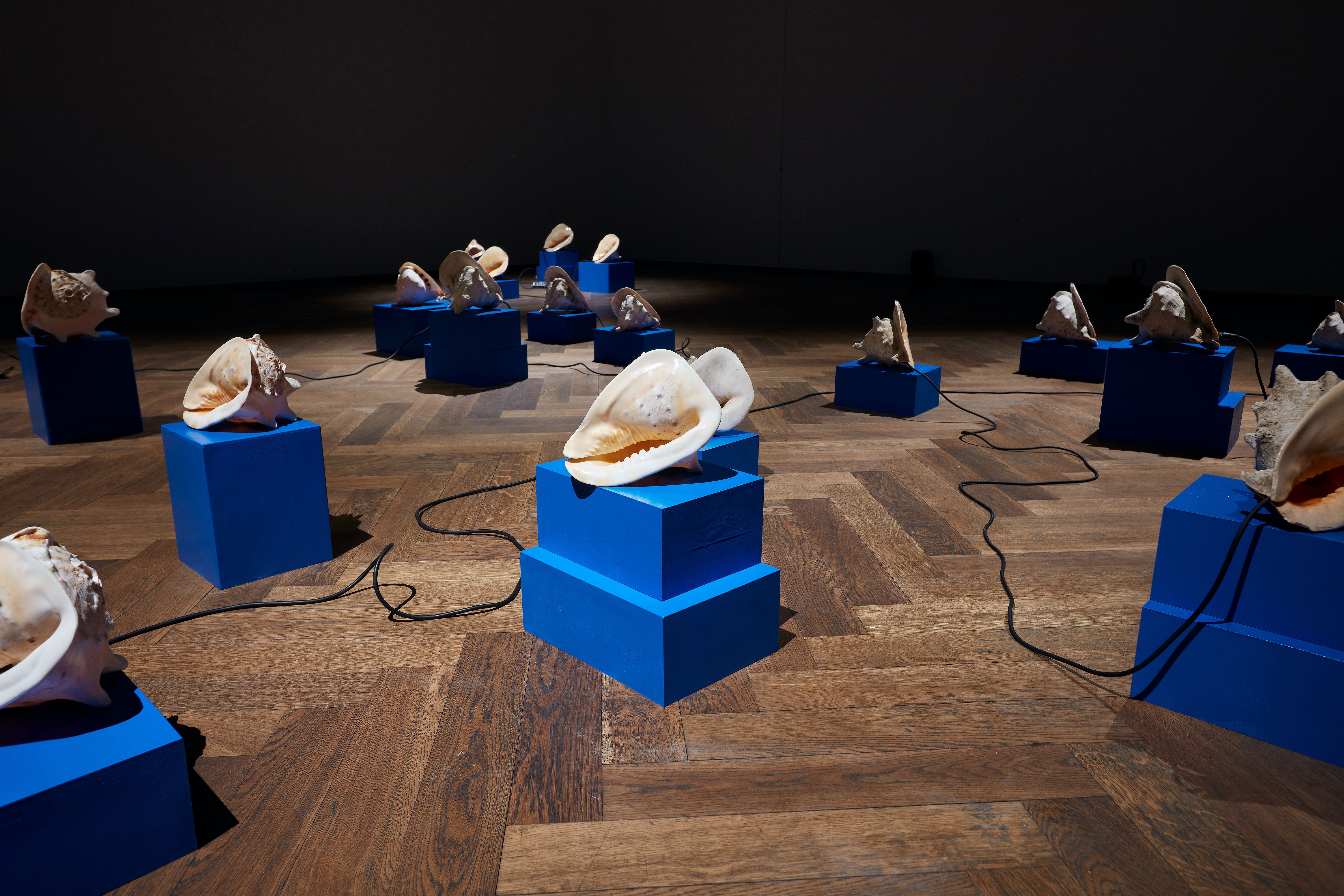

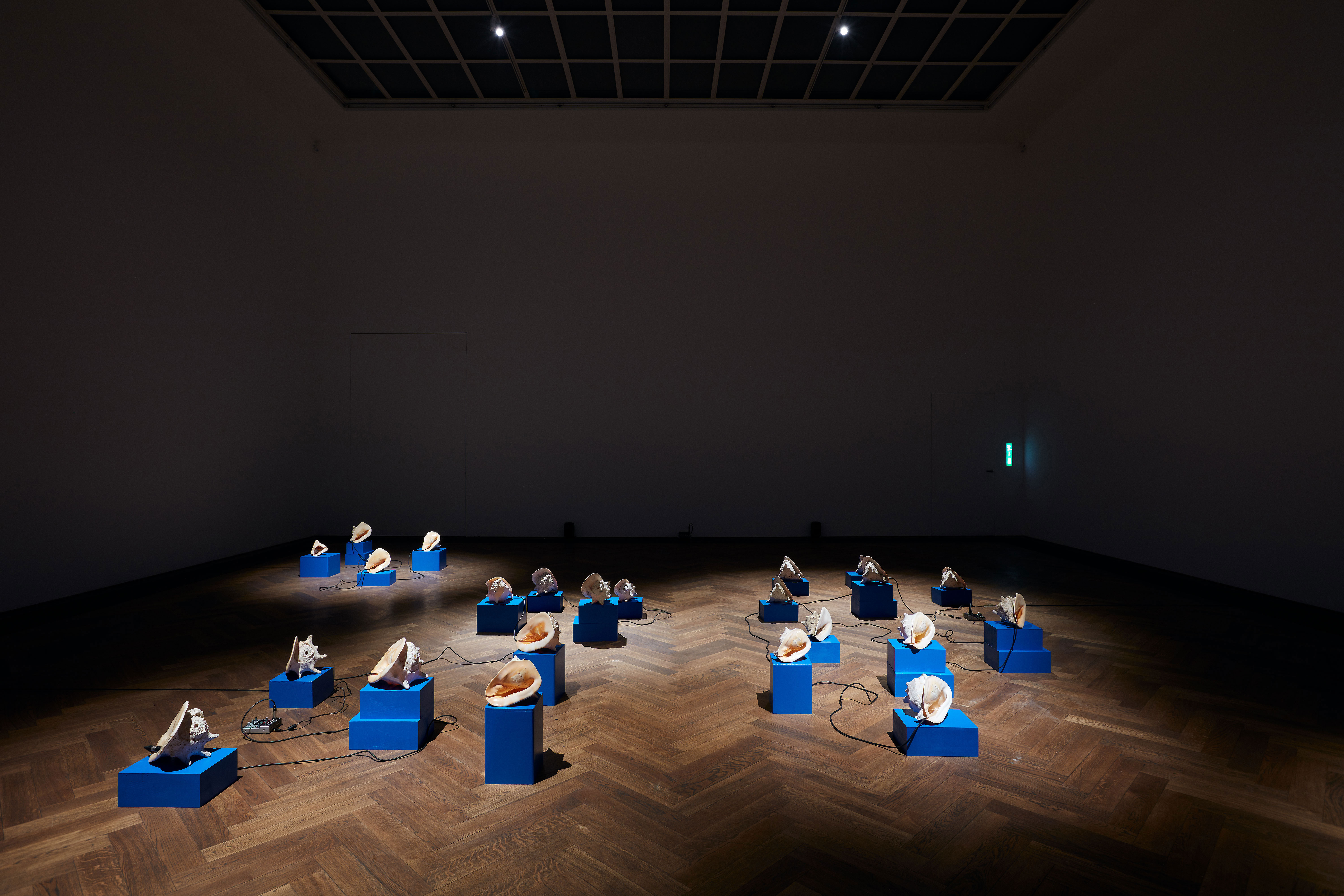

about fuga and ocean echoes
FUGA, sound installation,
2020 Ocean Spirit, Performance,
Aguilar, who originally trained as a classical musician, uses an ancient technique from his native Honduras to craft instruments out of seashells.
The loudspeakers in his sound installation FUGA play back recordings of himself breathing and blowing through these instruments.
The bodily intimacy and proximity of the sound evokes associations with wind and waves and makes the roar of the sea an almost palpable experience. Also close to Aguilar’s heart are the endangered coasts, oceans, and indigenous peoples of Honduras.
Conch trumpets were widely used among the native peoples of America and still serve the Garifunas, an African-indigenous ethnic group on the Caribbean coast, as a musical instrument and means of communication today.
The installation thus symbolizes the culture that in 1800 was driven off the island of St. Vincent and scattered to the four winds and its ancient spiritual ties to the sea.
Pável Aguilar, b. 1989, lives and works in Basel
2020 Ocean Spirit, Performance,
Aguilar, who originally trained as a classical musician, uses an ancient technique from his native Honduras to craft instruments out of seashells.
The loudspeakers in his sound installation FUGA play back recordings of himself breathing and blowing through these instruments.
The bodily intimacy and proximity of the sound evokes associations with wind and waves and makes the roar of the sea an almost palpable experience. Also close to Aguilar’s heart are the endangered coasts, oceans, and indigenous peoples of Honduras.
Conch trumpets were widely used among the native peoples of America and still serve the Garifunas, an African-indigenous ethnic group on the Caribbean coast, as a musical instrument and means of communication today.
The installation thus symbolizes the culture that in 1800 was driven off the island of St. Vincent and scattered to the four winds and its ancient spiritual ties to the sea.
Pável Aguilar, b. 1989, lives and works in Basel
©2025 pavelaguilar.com
“DEPARTURE”
Reunión II Performance Festival
Exposición Island, Honduras
Curated by Andreas Wagner and Adán Vallecillo
2020
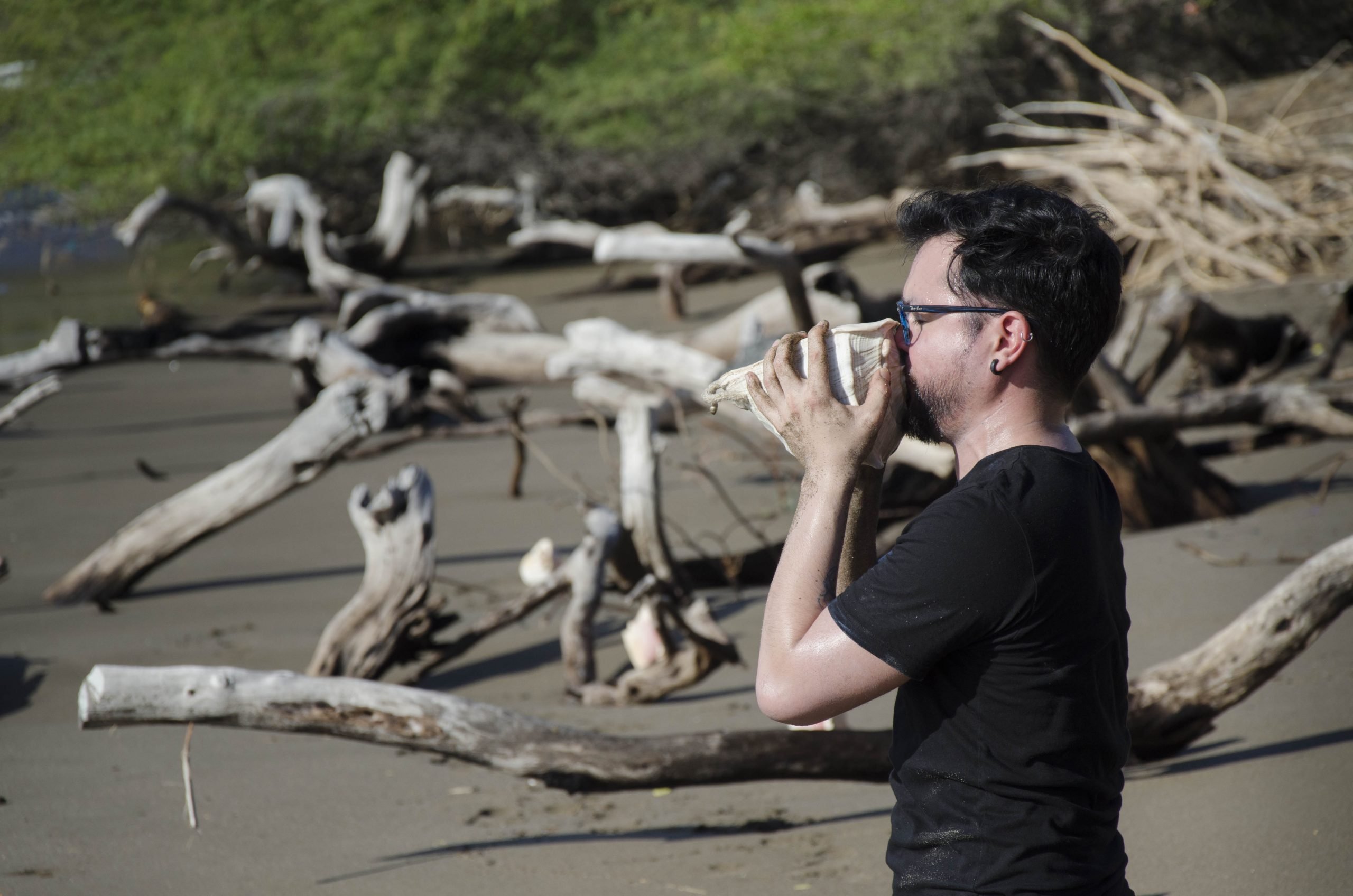
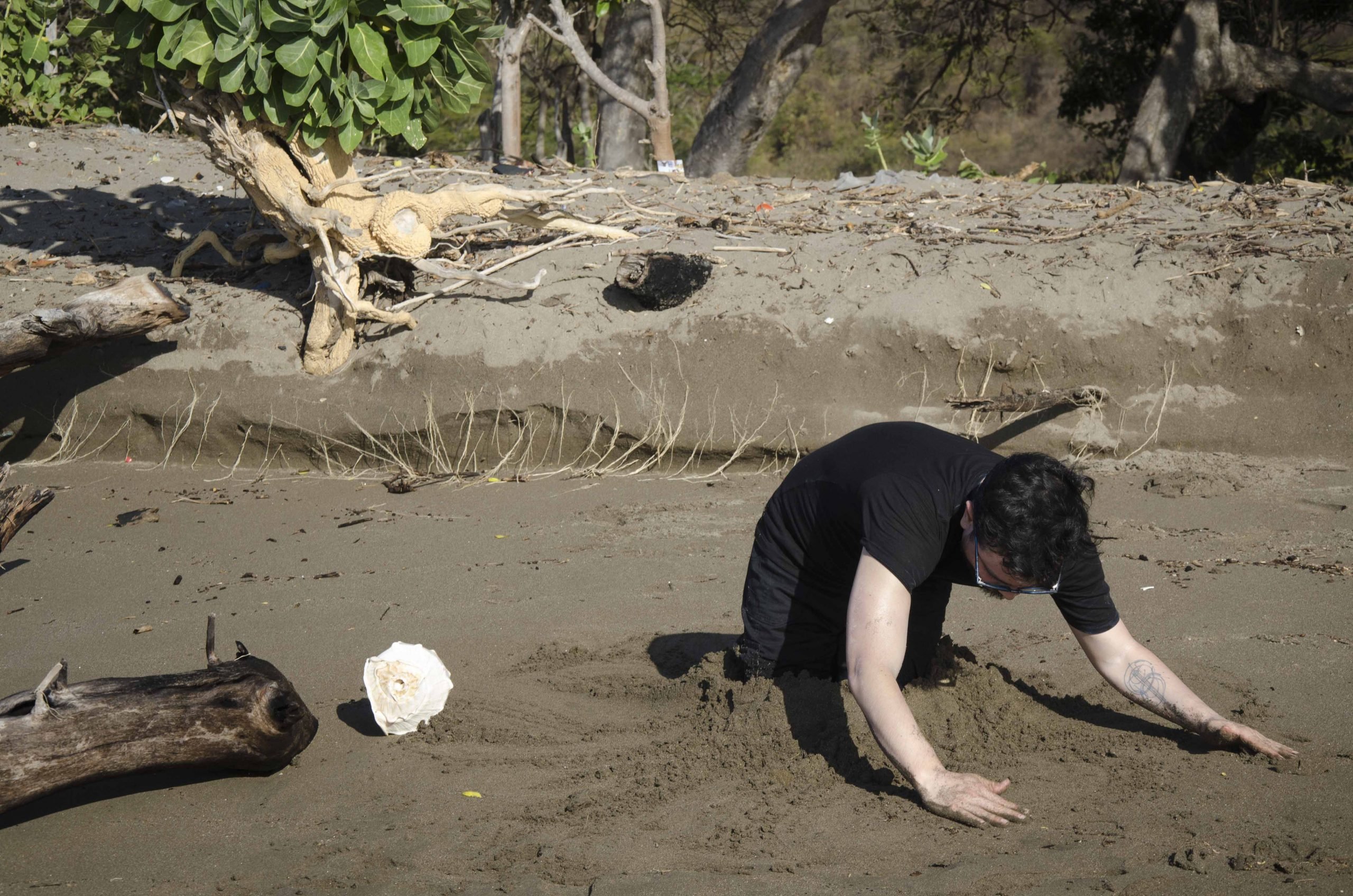

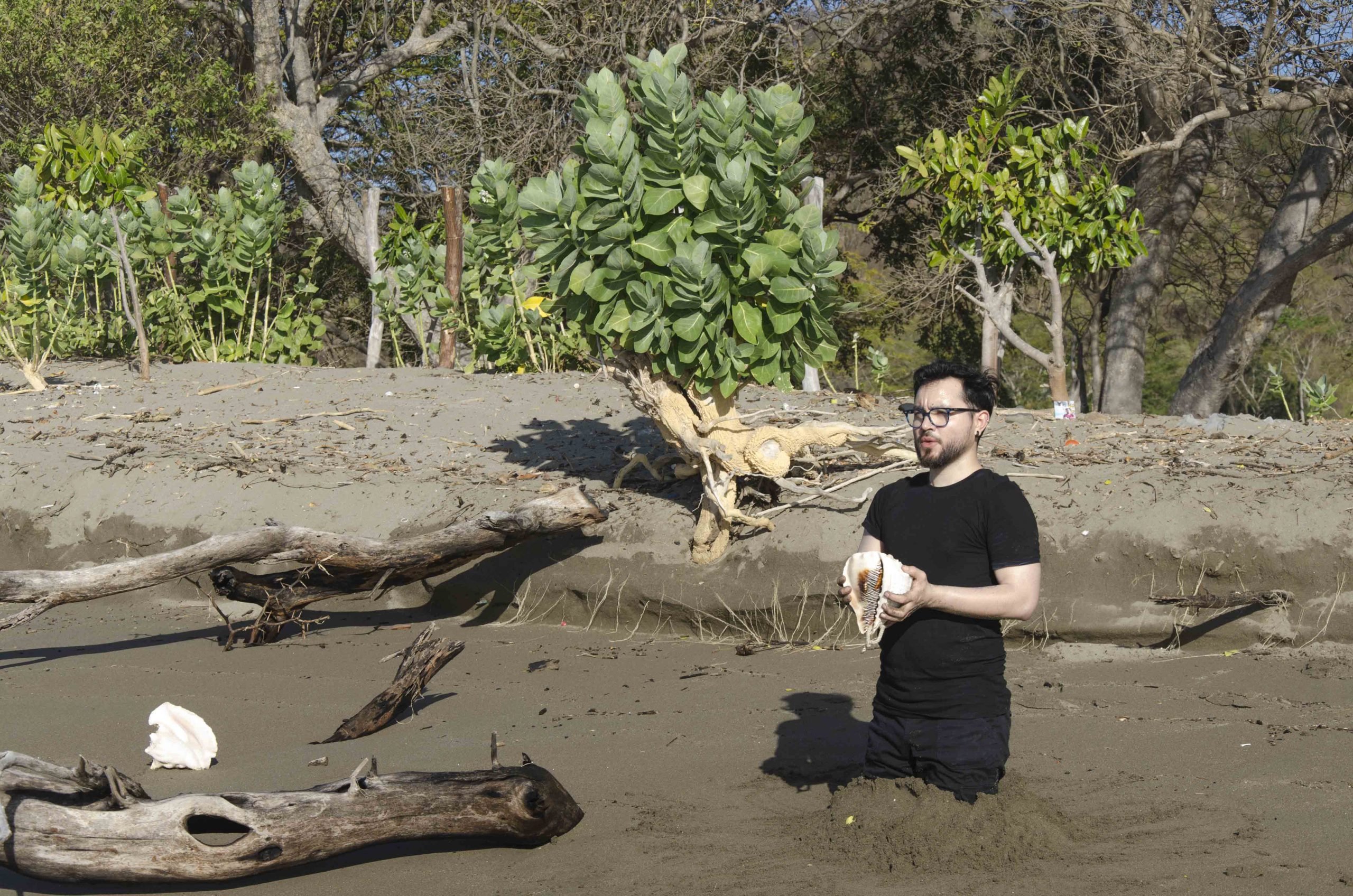
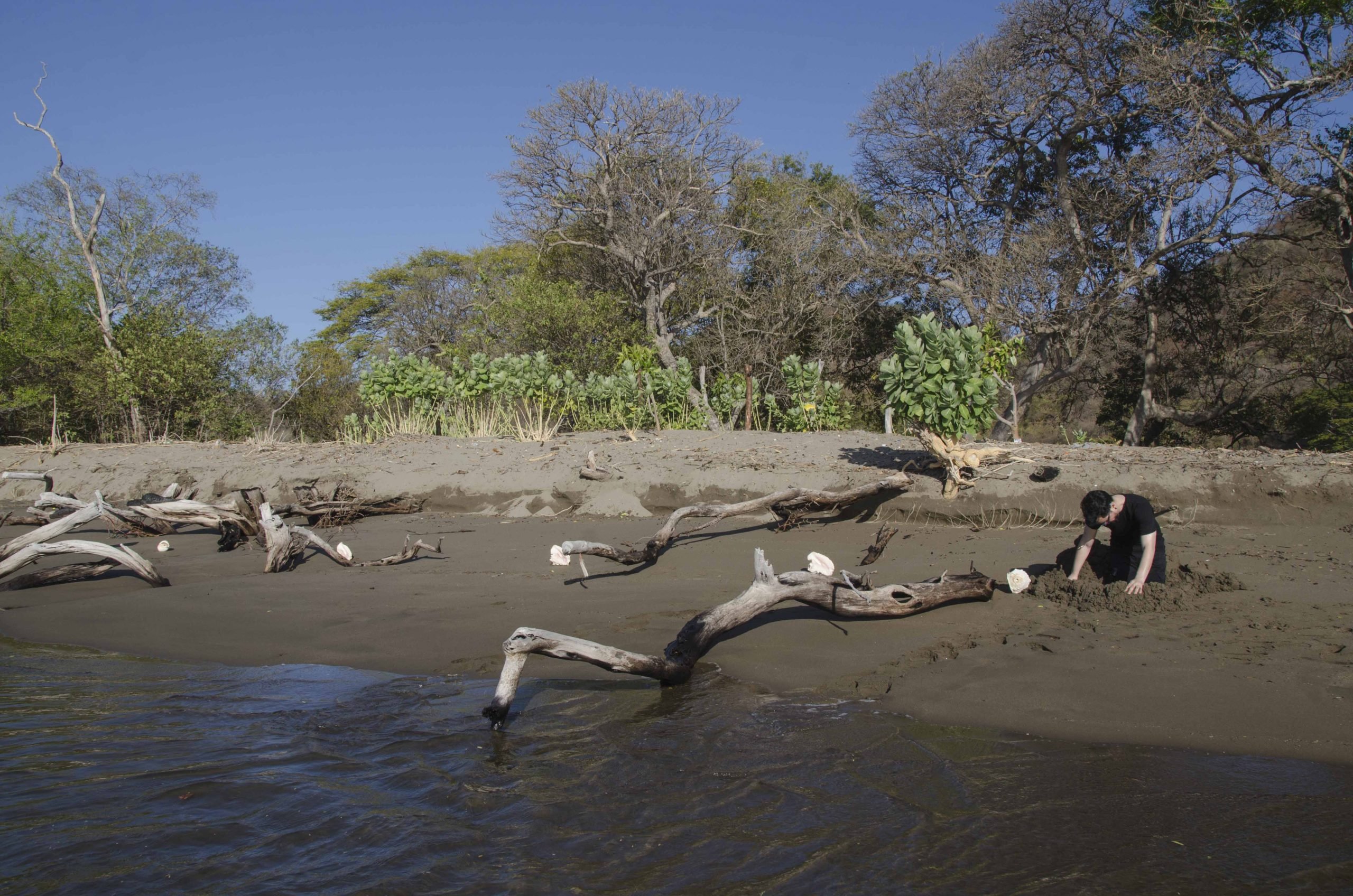
about departure
Shell horns have been used for centuries by indigenous and Pacific Island natives such as the Garifunas on the Caribbean coast of Honduras where I was born.
The shell horn is the only wind instrument used today in Garifuna traditional music and has a strong spiritual connection between the ocean and life.This instrument was commonly employed by Native Americans and may have also been used among West Africans, the exact origin and date of its initial use among the Garifuna are unknown. I learned to play it since I was a child.
The shell is made into a wind instrument when the pointed spiral top is cut off and the air is blown through the aperture with the lips. The closed, buzzing-lip embouchure used in playing orchestral brass instruments is also used to create the sound known as "the spirit of the ocean" through the shell.
Today I want to celebrate that we are alive and together in these uncertain times.
The shell horn is the only wind instrument used today in Garifuna traditional music and has a strong spiritual connection between the ocean and life.This instrument was commonly employed by Native Americans and may have also been used among West Africans, the exact origin and date of its initial use among the Garifuna are unknown. I learned to play it since I was a child.
The shell is made into a wind instrument when the pointed spiral top is cut off and the air is blown through the aperture with the lips. The closed, buzzing-lip embouchure used in playing orchestral brass instruments is also used to create the sound known as "the spirit of the ocean" through the shell.
Today I want to celebrate that we are alive and together in these uncertain times.
©2025 pavelaguilar.com